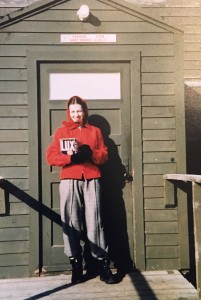By Jack El-Hai, Wonders & Marvels contributor
On a world map, Shemya Island appears as the tiniest of specks, if it appears at all. Yet this mostly uninhabited part of Alaska’s Aleutian Islands chain has played an important role in the history of aviation, as I learned when I researched and wrote Non-Stop: A Turbulent History of Northwest Airlines (University of Minnesota Press, 2013).

Northwest Airlines stewardess Phyllis Curry in front of the living quarters on Shemya Island, c. 1949
I first heard about Shemya from a retired stewardess named Phyllis Curry, who during the late 1940s worked on some of the earliest Northwest Airlines flights connecting the Continental United States with Asia. Using the “Circle Route” that went over the globe’s far northern reaches, these Northwest flights had to make several refueling stops. One was at Shemya, which must rank as the most remote and unlikely way station in the history of American commercial aviation.
Before Northwest’s use of the island, it had served the U.S. as a World War II military base. Set between the Pacific Ocean and the Bering Sea, the eight-square-mile island suffered from fog, strong wind, and desolation, but it allowed U.S. forces to combat Japanese incursions into Alaska and the North Pacific. After the war, Northwest took over the retired military facilities on the island.
During layovers to and from the Far East, stewardess Curry shared with other flight attendants a converted Quonset hut, which for a time bore a sign that read, “Home for Wayward Girls.” She recalled: “Because of all the snow, we couldn’t walk around, so [airline staff] would pick us up and drive us to meals which were given in another Quonset hut.” In their idle hours, employees played marathon poker games, hunted the Army’s garbage dump for souvenirs, and occasionally found stone tools from previous Inuit residents. They also kept track of a dog that had escaped from a Northwest passenger during a refueling stop and ran loose on the island for many years. “Whalebone sometimes washed up on the island…. I thought, “If only my mother could see me now,’” Curry said.
Later the U.S. military resumed use of Shemya and Northwest moved its refueling operation. Shemya’s military facilities, now called Eareckson Air Station, currently house early-warning radar equipment and are run under the management of a caretaker contractor.
Further reading
Bachman, Justin. “This Remote Island is the Last Place Pilots Want to Land a Plane.” Bloomberg.com, July 29, 2015.
